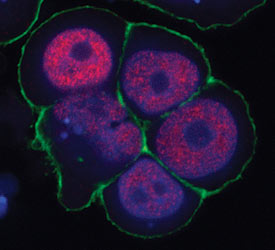Nuclear Receptors
CST signaling pathway diagrams allow you to click on individual nodes to find research resources or product information. You can also download the pathway diagrams for educational and research purposes.
The nuclear receptor superfamily are ligand-activated transcription factors that play diverse roles in cell differentiation/development, prolif- eration, and metabolism and are associated with numerous pathologies such as cancer, cardiovascular disease, inflammation, and reproductive abnormalities. Members of this family contain an N-terminal transactivation domain, a highly conserved central region zinc-finger DNA binding domain, and a C-terminal ligand-binding domain. Ligand binding to its correlate nuclear receptor results in transactivation of specific genes within a target tissue.
Type I nuclear receptors, also called steroid receptors, include the estrogen receptor, androgen receptor, progesterone receptor, and glucocorticoid receptor. Steroid hormone ligands for this subgroup of receptors travel from their respective endocrine gland through the bloodstream bound to steroid binding globulin. Some type 1 nuclear receptors are activated, in part, upon binding their respective ligand in the cytoplasmic compartment. The ligand-receptor complex enters the nucleus where it homodimerizes, dissociates from HSP90, and binds a hormone response element within the promoter of a target gene. The receptor transactivation domain is responsible for interaction at the promoter with acetyltransferases, co-activators, and the general transcription machinery (TBP, TFIIB, RNA polymerase II), thereby resulting in transcriptional activation.
Type II non-steroid nuclear receptors include thyroid hormone receptor, retinoic acid receptor, vitamin D receptor, and PPARγ. Members of this family heterodimerize with the retinoid X receptor (RXR). Prior to ligand binding, receptor heterodimers are located in the nucleus as part of complexes with histone deacetylases (HDACs) and other co-repressors that keep target DNA in a tightly wound conformation, preventing exposure to transactivation factors. Ligand binding results in HDAC dissociation, chromatin derepression, and transcriptional activation.
In addition to ligand binding, nuclear receptor activity can be modulated through the action of numerous growth factor and cytokine signaling cascades that result in receptor phosphorylation or other post-translational modifications, typically within the N-terminal transactivation domain. For example, the estrogen receptor is phosphorylated on multiple serine residues that affect receptor activity. Ser118 may be the substrate of the transcription regulatory kinase CDK7, whereas Ser167 may be phosphorylated by p90RSK and Akt. Phosphorylation of Ser167 may confer resistance to tamoxifen in breast cancer patients.
References:
- Tata JR (2002) Signalling through nuclear receptors. Nat. Rev. Mol. Cell Biol. 3(9), 702–10.
- Rochette-Egly C (2003) Nuclear receptors: integration of multiple signalling pathways through phosphorylation. Cell. Signal. 15(4), 355–66.
- Gronemeyer H, Gustafsson JA, Laudet V (2004) Principles for modulation of the nuclear receptor superfamily. Nat Rev Drug Discov 3(11), 950–64.
- Perissi V, Rosenfeld MG (2005) Controlling nuclear receptors: the circular logic of cofactor cycles. Nat. Rev. Mol. Cell Biol. 6(7), 542–54.
- Lefebvre P, Benomar Y, Staels B (2010) Retinoid X receptors: common heterodimerization partners with distinct functions. Trends Endocrinol. Metab. 21(11), 676–83.
- Kato S, Yokoyama A, Fujiki R (2011) Nuclear receptor coregulators merge transcriptional coregulation with epigenetic regulation. Trends Biochem. Sci. 36(5), 272–81.
- Berrabah W, Aumercier P, Lefebvre P, Staels B (2011) Control of nuclear receptor activities in metabolism by post-translational modifications. FEBS Lett. 585(11), 1640–50.
- Wiench M, Miranda TB, Hager GL (2011) Control of nuclear receptor function by local chromatin structure. FEBS J. 278(13), 2211–30.
- Hammes SR, Levin ER (2011) Minireview: Recent advances in extranuclear steroid receptor actions. Endocrinology 152(12), 4489–95.



